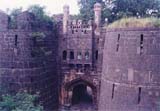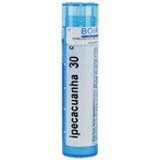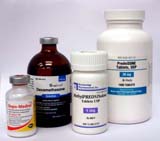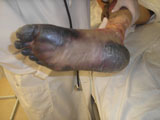Homoeopathy
Some of my memorable cases
Editor’s Note
It is a popular belief that homoeopathy treats only chronic, non-serious problems like an itch or a wart. These cases reveal that, if based on a homoeopathic principle, homoeopathic remedies provide quick and effective relief.
For a homoeopath each case is a memorable event because no two cases are alike. However, there are certain cases that linger in one's memory. They need not be complicated or chronic cases, but are the ones that we come across in our early years of homoeopathic practice. They are greatly memorable when they happen to be our near and dear ones or a personal experience.
Case I
Many years ago, around 1970, on a routine visit to Poona I met one of my classmates, a famous surgeon, who was operating on a patient suffering from an enlarged prostate. I saw him periodically straighten his back and wince with pain. After the operation was over, I asked him about it. He said “I have been suffering from sharp intermittent shooting pains across the mid-thoracic region for the last two to three months, especially after a heavy operative schedule. Various possibilities like osteochondritis, early tuberculosis and cyst in the vertebral bone have been thought of but all investigations have proved normal.”
As there was no clear modality in his symptoms, I asked whether he had had such pains before. He remarked, “Now that I come to think of it, I do recollect a mild but similar type of pain in housemanship, when I fell off from a motor cycle. I had a mild concussion and was hospitalised for some days. This back pain also arose then. Now the pains are similar but more intense.” This information was enough for me to give him Arnica montana 1M, 3 doses to be taken hourly.
In my next visit after a month, I enquired about the pain. He remarked that by the third day all the pains had ceased. He made another surprising statement:
“Your medicine changed my whole body in a way that I never told you or anybody about. Earlier I could not smell my wife’s cooking or perfumes. I had lost the sense of smell. Now there is a tickling sensation in my nose and the sense of smell is exaggerated. This is disagreeable.” I assured him that even this would normalise and wondered if a dose of Arnica could revitalise the olfactory nerve which had not worked for years.
His back pains have not recurred though he again lost his sense of smell. If this is not a memorable case, what else?
Case II
I had just begun learning homoeopathy, way back in 1963 with my friend Dr. V.D. Nagvanshi of Solapur – a very thorough homoeopath, practising classical homoeopathy. One day I landed up with high fever, chills, rigours and a small but very painful boil inside the left nostril. I did not take any medicine for one or two days. My knowledge of anatomy made me wonder whether it could lead to cavernous sinus thrombosis. Dr. Nagvanshi trooped in, asked many questions, popped in a dose and remarked, “Let’s see after 24 hours.” There was no response. Fever, chill and boil remained status quo. The nose was hot, red and shiny. The pain was very disturbing. The next day Dr. Nagvanshi came again, asked a few more questions and put in another dose. I remember sleeping within fifteen minutes of that. The fever began to subside within an hour and by the next day I was apyrexial. Seventy percent of the pain had subsided. In another 24 hours I was absolutely fine. I do not think even an antibiotic could have worked that fast. A few months later, I hesitatingly asked him about the prescription. He told me that the first dose was Ipecacuanha 30 and the latter Lachesis 200.
Case III
A month ago, while writing, I somehow happened to injure the pulp of the middle finger of my right hand by the sharp tip of a pen. Within 15 seconds I began to have severe pains at the site. I rushed to the tap to pour water and wipe out the ink, but the pain persisted. A minute had passed and the pain was spreading to the rest of the finger. It was worse on letting the hand down. I found a bottle of Hypericum Q but it was totally empty. I took this dry bottle of Hypericum Q, added half an ounce of water into it, shook it a few times and applied it to the injured area. Imagine my surprise when within seconds the severe pain started decreasing, ceased within a minute and I could continue writing with the same finger.
Case IV
This is the case of a very close family member. On 30-06-91, she was bitten on her wrist while working in the garden in the evening. What had bitten her was not clear. She had itching at the spot which spread to the whole body. She had a feeling that cold water would help her so rushed to the bathroom for a cold bath. I just heard a loud shout for help and entering the bathroom found that she had lost consciousness after a large vomit. I could hardly feel the pulse. She was sweating on the head. While she was in my arms, I advised my sister to give her Aconite 30 every minute. After three doses she became conscious again. With some difficulty she was taken to her bed but was extremely uneasy with the sensation of itching and scratching all over. She then developed a crampy lower abdominal pain with a desire to pass stools and was tossing from side to side in the bed due to pain. A dose of Colocynthis 200 was given. It acted almost in a minute and the pain reduced remarkably. The desire for stools also subsided. The erythema and redness persisted and at some places elevated eruptions were seen. She desired constant fanning, slept a bit and then began to feel chilly and wanted covers. By 9 p.m. this condition too improved and the patient slept well the whole night. She was given a few doses of Ledum Palustre 30, assuming that this episode was due to an insect bite. The next day showed only minimal swelling around the site of bite.
On 22-12-93, in the evening, an intense itching in the head and fingers began, but this time there was no mark of any bite anywhere, no nausea or vomiting. An intense warmth all over the body was felt with a desire to wash her arms under a cold tap water which reduced the itching and heat. She felt a mild constriction and tightness of the chest while breathing. Immediately Ledum Palustre 30 was given, every ten minutes in water 8 to 10 times. I was a bit worried due to the bronchospasm but Ledum controlled everything. By 9 p.m., except a lingering heaviness in the chest and swelling of the index finger, which was warm and red, there was no problem. Nothing more was given. The swelling subsided after 3 days.
On 01-04-95, there was a sensation of being bitten on the right side of the neck around evening while walking on the road near our residence. She was already suffering from cough and fever. In this episode, some some symptoms of intense redness, heat and itching were also there. Because of the bite in the neck I was concerned about laryngeal oedema, remembering the second episode of mild bronchospasm. The whole skin was covered by small reddish, circular, elevated lesions like hives. This time I gave her Apis mellifica 30 in water every five to ten minutes. My reason for giving Apis over Ledum this time was the proximity of the bite to the laryngeal apparatus. In all the three episodes, there was no appreciable change in thirst. Only ‘relief by cold application’ was a prominent modality. Twenty-five minutes after Apis, the scratching was ameliorated by 70 percent. Three hours later, there was almost no itching but she started having pain in the small joints of the fingers. She recollected that this had happened the in the previous attacks also. The mark on the neck remained as a slight puffy swelling for almost four days after the bite.
There has been no recurrence in the past year and a half.
Retrospectively, I wonder how these three episodes of anaphylaxis would have been treated in a non-homoeopathic set-up. They would have surely required intravenous fluids, corticosteroids and hospitalisation. As the patient was my wife, you can imagine the psychological pressure on me to choose the correct remedy!
Case V
In 1968, as an associate-Professor of Surgery, I had started giving homoeopathic medicine to my patients in the surgical ward. There was a man who had been diagnosed as Buerger’s and had come to my unit with gangrene of the right foot. All toes were affected and the skin over the metatarsal joints was also showing gangrenous changes. The patient had already undergone lumbar sympathectomy without the slightest benefit. Fortunately the gangrene was of a dry type but there were severe burning pains day and night. Knee amputation would have been the standard surgical approach. The patient was given a few doses of Tabacum 30 as there was a history of smoking. In fact he was smoking 1-2 cigarettes a day even in the ward. Secale cornutum 30 TDS was administered regularly. No antibiotic or vasodilator was given. Only Calendula dressing was faithfully done by my house staff. After 12-15 days, a line of demarcation of healthy tissue appeared. One fine morning while dressing, the metatarsal bones just snapped off at the centre and the whole gangrenous part detached itself, to the surprise of my house staff and senior colleagues of the adjoining surgical unit (who had been watching with sceptical interest). When the patient went home with an almost completely healed wound, my colleague wanted to know what medicine I had given in order to use it for all gangrenous cases. I refused to oblige him, saying that he should first learn homoeopathic principles.
Dr. D.E. Mistry is a surgeon cum homoeopath who has followed an inner guide throughout his life and practice.
Share with us (Comments, contributions, opinions)
When reproducing this feature, please credit NAMAH, and give the byline. Please send us cuttings.




